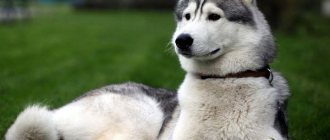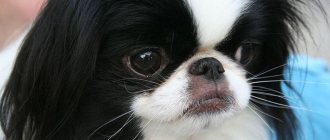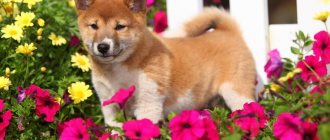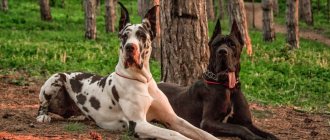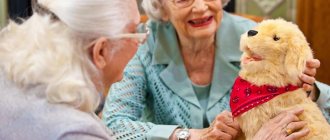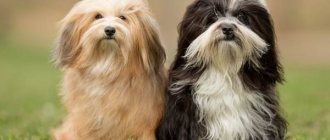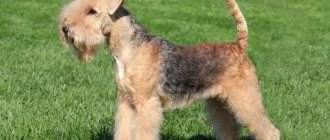Breed characteristics
The weight of a Korean male ranges from 18-23 kg, and females - from 15 to 19 kg. The pet's height at the withers reaches up to 54 cm, it has a triangular head shape with erect ears and small eyes. The animal's tail is curled into a ring, the fur is long and thick.
This is interesting! The color of the breed can be different: beige, yellow, fawn, gray or black.
Various colors of the breed
Advantages and disadvantages
The list of advantages of the breed is very large, here are some of them:
- attachment to one owner;
- ease of care;
- friendliness and obedience;
- is an excellent watchman and security guard;
- the pet is active and has well-developed mental abilities.
The disadvantages include the following:
- difficulty in purchasing a puppy, because it is impossible to take it outside of Korea;
- high cost of a pet;
- aggressiveness towards strangers and animals.
Health
The Jindo is generally a healthy and long-lived breed. The Korean Chindo breed often has a lifespan of 14 years or more, and most live long, healthy lives.
There are very few health problems in the breed. The most common problems are allergies and hypothyroidism. There are cases of cataracts and hip dysplasia. Systematic veterinary examination and vaccination will ensure a full, healthy life for your pet.
Download the specialized application for pet owners Petstory on the IOS and Android platforms using the link – https://petstory.ru/prilozhenie-konsultacija-veterinar/.
Breed standard
Jindo dogs are characterized by a proportionally built body of medium size and, according to established standards, have the following characteristics:
- Head. It has a blade shape that tapers towards the eyes.
- Jaws and teeth. The pet has a scissor bite, the upper lip hangs over the lower, and the tongue in some breeds may be blue or light blue.
- Nose. Dark-colored dogs have a black nose; light-colored dogs may have a lighter nose.
- Eyes. Small, round, low-slung.
- Ears. With a thick auricle covered with small hairs.
- Neck. Massive and wide.
- Frame. Straight, strong, with a not very broad chest.
- Limbs. Quite strong, medium height. The front legs are straight and the hind legs are at a slight angle. The paws are more reminiscent of a cat's in appearance, with strong black claws.
- Tail. Rolled into a ring and set high.
- Wool. Thick, silky and has a soft undercoat.
- Color. It can be very diverse: black-brown, white, gray, fawn, brindle, red and white.
Breed standard
Appearance
White-colored Chindo (baekku)
Chindo are medium-sized Spitz-type dogs with a wild-type double coat. It differs from other Spitz breeds and mixed breeds in the proportions of the skull, muzzle, head and body. The Korean Chindo gives the impression of being an intelligent, strong, agile and alert dog. Sexual dimorphism is strongly expressed in the breed: the male’s head is wider, high cheekbones, with a powerful muzzle, the female’s head is lighter and has a triangular shape, in general the females are more elegant[10]. The head, when viewed from above, is triangular in shape. The ears are erect, the muzzle is straight. The nose is black, in white dogs it is pink. The eyes are dark, rather small, with a lively expression, the outer corners of the eyes are raised towards the ears. The tail is long, in the shape of a half ring or ring, touching the back[4].
The breed is traditionally divided into two types of build:
- Thongol
(Korean 통골) or
Kyopke
(Korean 겹개): a more muscular and stocky dog, the height at the withers is equal to the length of the body; the depth of the chest is approximately equal to half the height at the withers; loin is short. - Hoodoo
(Korean: 후두) or
Hyotke
(Korean: 혓개): A slimmer dog, with a slightly shallower chest depth and a slightly longer loin. The head, ears, and muzzle are also longer, the ratio of height to body length is 10:11.
The Korean National Canine Association also recognizes a third body type, Kakkol.
(Kor. 각골), intermediate, with an elongated body and deep chest.
The colors allowed in the breed are: fawn, black, black and tan, brindle, gray (wolf, formed by a mixture of white, black and fawn hair), as well as white - light fawn with brown or light brown tips of the ears, tail and the back of the hindquarters legs and sometimes a belt along the back. The undercoat is dense and light in color[4].
Character
Chindo is a breed of dog that is distinguished by its good nature and great love for children. Pets are loyal to their owner and, in case of separation, can travel hundreds of kilometers in search of him. Jindo (Chindo) are very curious and intelligent. They can be trained, but due to their restless nature, it may take a little longer.
Important! They don’t like closed spaces, and if they find themselves in such a situation, they will tear up furniture and wallpaper just to break free.
The Jindo breed is a hunting breed, distinguished by its consistency and courage. Pets can hunt both medium and large sized game.
History of the breed
Loyal, charming and intelligent, the Korean Jindo (Jindo, Hindo Dog) developed as a breed on the island of Jindo off the southwest coast of Korea.
For thousands of years they have been bred for group or solo hunting of boar, rabbits, badgers and deer. Quite naturally, the Korean Chindo - a descendant of Mongolian guard dogs - turned into a breed with exceptional hunting abilities. It is common for a dog of this breed to kill its prey and then lead its owner to it.
Despite the ban on the export of dogs from the country, Korean Jindo first appeared in the United States in the 1980s. One of the rarest breeds, the Korean Chindo, was registered in the American Kennel Club in 2008, and in the International Film Festival in 1995.
Dogs of this breed are protected by Korean law as a national treasure. His legendary loyalty and affection for his owner, free-spirited nature, high intelligence and unfailing courage have made the Jindo the most popular dog breed in Korea.
In its native country, Korean Jindo is called “Natural Treasure No. 53”, called jindoke or jindo-kyon. Koreans are crazy about dogs because of their loyalty and ability to always return to their owner. The dog never forgets his affection for the owner who raised him from a puppy.
As an ancient national breed, the Korean Jindo has always been popular, but skyrocketed to fame in 1993 when the story of a 7-year-old dog named Baekgu made headlines.
Baekgu lived on Jindo Island with his owner, an 83-year-old woman named Park Bak-dong, before he was sold to a new owner in a city 180 km away. The dog ran away from his new home and only six months later appeared in the owner’s yard. This touching story formed the basis of films, comics and cartoons.
Education and training
Chindo is a dog that needs proper training to be kept at home, because it has wild instincts and a wayward character. During training, the dog needs a firm hand and strictness so that it understands who is in charge. It is imperative to force the dog to obey and strictly follow all commands, but at the same time it is necessary to treat him with respect, because the breed is proud and will not tolerate disrespect.
Chindo training
Rules of maintenance and care
Chindos are not suitable for keeping in an apartment; they need quite heavy physical activity. A country house with adjacent territory and a high fence would be ideal. The pet can easily overcome obstacles up to 1.5 meters. Given the presence of an insulated enclosure, this dog can live in outdoor conditions.
This breed is a born hunter. They can be trained on wild boars and moose.
You need to walk the dog for a long time, adding games, running and other activities to a simple walk.
Nutrition depends primarily on her activity level. During puppyhood, the pet is given small portions 5-6 times a day, the emphasis is on fermented milk products. In adulthood - lean meat and fish. You should add porridge, vegetables and fruits to them.
Prohibited products:
- potato;
- flour and sweets;
- bones;
- fatty and smoked.
When choosing dry food, veterinarians advise giving preference to premium class and higher.
When using the dog's working qualities, you should not feed it too cold or, conversely, hot food! What can cause a dull sense of smell?
The rest of the care is quite simple:
- brush the fur once or twice a week;
- brush teeth and ears as needed;
- Claws should be trimmed once a month if they do not wear off on their own.
Chindo doesn't like water!
Walking in the rain, going to the lake and washing your dog can be a chore!
Walking, physical activity and rules of safe behavior on the street
jindo, you need to remember that dogs need regular walks. It is recommended to take them to a special area where they can develop their mental and physical abilities.
If you don’t give your pet enough attention, he will start looking for entertainment on his own, and the owner will not always like it. For example, a jindo can dig under a fence and break free, where it will do whatever it wants.
Note! When walking Jindo on the street, you should be careful, because he often shows aggression towards cats, dogs and other animals.
Rare dogs. Description and characteristics of rare dog breeds
There are less than 4,000 Norwegian Elkhounds left. The breed was bred for moose hunting. Elghund means "elk dog" in Norwegian. Its history dates back to 1877.
Pictured is a Norwegian Elkhound
By the 21st century, moose hunting had become exotic. Along with it, Elkhounds lost their relevance. But, their situation is better than that of the Dupuis, Cordoba Fighting Dog, Norfolk Spaniel, Alpine Mastiff and Sahtu.
These breeds disappeared completely. As you can see, you can create a separate “Red Book” for dogs. In it, as in the regular edition, it is worth noting the pages with restored species.
A number of rare breeds are once again gaining popularity. Let's learn about those who can avoid the fate of disappeared dogs if they continue to win the sympathy of people.
Features of feeding and diet
Dogs are not picky about food, so they will eat whatever is given to them. In normal life, jindos are able to get their own food. When keeping at home, do not forget that your pet needs to be regularly given vitamins and other supplements that are beneficial for bones and fur.
Important! You can find out the names of the necessary drugs from your veterinarian or veterinary pharmacy.
Feeding the dog
It is also recommended to give Jindo special dog food, which contains all the useful and necessary vitamins and microelements.
Feeding rules
Your pet should receive high-quality dog food, whether it is factory-made or home-prepared with the approval of your veterinarian. Any diet should be appropriate for the age of the dog (puppy, adult or senior).
Jindos are not gluttonous and are practically not prone to obesity. Their slender appearance often prompts owners to worry about their diet. It is extremely easy to turn Chindos into picky eaters by giving them food whenever they want or giving them treats to entice them to eat.
Consult your veterinarian if you have any concerns about your dog's weight or diet. Clean, fresh water should always be available to your pet.
How to choose a puppy
If you want to buy a Korean dog, it will be impossible to do this on the territory of Russia, because there is not a single registered nursery where they breed this breed. In Korea, they closely monitor the movement of animals and prevent their export to other countries.
Many people are interested in how much a puppy will cost. In Korea, the price for such a dog is high - about 60 thousand rubles*. Each puppy has a pedigree, and the breed is considered to be elite. But even if you manage to buy a puppy in Korea, you still won’t be able to take it home.
Korean Chindo puppy
Note! If you somehow managed to find a Korean puppy in Russia, you should carefully study the documents for it, because scammers can pass off similar breeds as Korean and demand a considerable amount of money.

